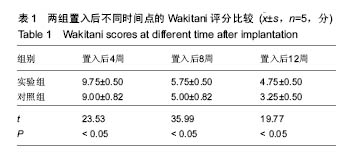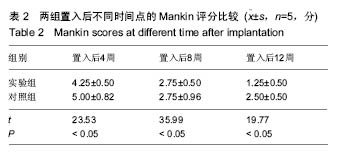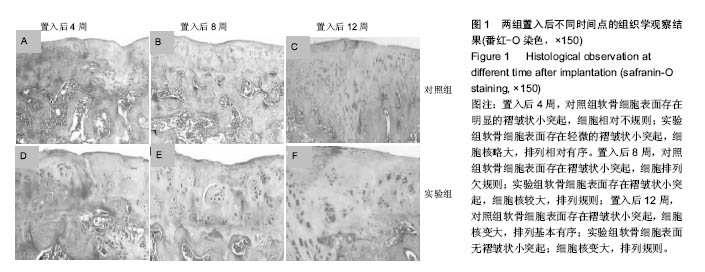| [1]Vo N,Niedernhofer LJ,Nasto LA,et al.An overview of underlying causes and animal models for the study of age-related degenerative disorders of the spine and synovial joints.J Orthop Res.2013;31(6):831-837.[2]张仲文,侯世科,杨造成,等.基质诱导的自体软骨细胞移植术修复膝关节软骨缺损10例术后2年的随访[J].中华关节外科杂志(电子版),2010,4(6):17-21.[3]Komárek J,Vali P,Repko M,et al.Treatment of deep cartilage defects of the knee with autologous chondrocyte transplantation: long-term results.Acta Chir Orthop Traumatol Cech.2010;77(4):291-295.[4]Lim HC,Bae JH,Song SH,et al.Current treatments of isolated articular cartilage lesions of the knee achieve similar outcomes.Clin Orthop Relat Res. 2012;470(8):2261-2267.[5]Kelly TA,Roach BL,Weidner ZD,et al. Tissue-engineered articular cartilage exhibits tension-compression nonlinearity reminiscent of the native cartilage.J Biomech. 2013;46(11):1784-1791.[6]Schwarz S,Koerber L, Elsaesser AF,et al.Decellularized cartilage matrix as a novel biomatrix for cartilage tissue-engineering applications.Tissue Eng Part A.2012; 18(21-22):2195-2209.[7]Cheng H,Byrska-Bishop M,Zhang CT,et al.Stem cell membrane engineering for cell rolling using peptide conjugation and tuning of cell-selectin interaction kinetics. Biomaterials.2012;33(20):5004-5012.[8]刘清宇,王富友,杨柳.关节软骨组织工程支架的研究进展[J].中国修复重建外科杂志,2012,26(10):1247-1250.[9]李元城,张卫国,秦建华,等.微流控芯片上胰岛素样生长因子1和碱性成纤维细胞生长因子对兔关节软骨细胞增殖的影响[J].解放军医学杂志,2013,38(6):476-480.[10]伏治国.瞿玉兴.关节镜下自体镶嵌式骨软骨移植修复膝关节股骨髁软骨缺损[J].实用医学杂志. 2011.27(22):4094-4095.[11]Wood JJ,Malek MA,Frassica FJ,et al. Autologous cultured chondrocytes: adverse events reported to the United States Food and Drug Administration.J Bone Joint Surg Am.2006; 88(3):503-507.[12]Bentley G,Biant LC,Carrington RW,et al.A prospective,randomised comparison of autologous chondrocyte implantation versus mosaicplasty for osteochondral defects in the knee.J Bone Joint Surg(Br). 2003;85(2):223-230.[13]Salzmann GM,Sah BR,Schmal H,et al.Microfracture for treatment of knee cartilage defects in children and adolescents. Pediatr Rep.2012;4(2):e21.[14]Mithoefer K,McAdams T,Williams RJ,et al.Clinical efficacy of the microfracture technique for articular cartilage repair in the knee: an evidence~based systematic analysis.Am Sports Med. 2009;37(10):2053-2063.[15]Pestka JM,Schma H,Salzmann G,et al.In vitro cell quality of articular chondrocytes assigned for autologous implantation in dependence of specific patient characteristics.Arch Orthop Trauma Surg. 2011;131(6):779-789.[16]Ebert JR,Robertson WB,Woodhouse J,et al.Clinical and magnetic resonance imaging~based outcomes to 5 years after matrix-induced autologous chondrocyte implantation to address articular cartilage defects in the knee.Am Sports Med.2011;39(4):753-763.[17]Hirschmuller A,Baur H,Braun S,et al.Rehabilitation after autologous chondrocyte implantation for isolated cartilage defects of the knee.Am J Sports Med.2011;39(12): 2686-2696.[18]Wondrasch B,Zak L,Welsch GH,et al.Effect of accelerated weight bearing after matrix~associated autologous chondrocyte implantation on the femoral condyleon radiographic and clinical outcome after 2 years: a prospective,randomized controlled pilot study.Am Sports Med.2009;37(Supp1):88S-96S.[19]钟进聪,王震.大众体育与竞技体育运动损伤的成因及对策[J].广州体育学院学报,2014,34(1):109-111.[20]张卉,董学君,邵健忠,等.改良人骨髓间充质干细胞分离方法提高细胞定向分化能力[J].医学研究杂志, 2010,39(9):57-62.[21]Alves da Silva ML,Martins A,Costa-Pinto AR,et al. Chondrogenic differentiation of human bone marrow mesenchymal stem cells in chitosan-based scaffolds using a flow-perfusion bioreactor.J Tissue Eng Regen Med.2010;12: 29.[22]朱雷,吕丹.不同环境刺激对骨髓间充质干细胞成软骨分化作用的研究进展[J].中国矫形外科杂志, 2010,18(19):1618-1621.[23]杨波,胡蕴玉.胶原/羟基磷灰石骨软骨一体化支架的生物学特性研究[J].中国矫形外科杂志,2010,18(4):304-307.[24]张文元,杨亚冬,房国坚,等.壳聚糖-丝素复合支架材料与骨髓间充质干细胞相容性的研究[J].中国卫生检验杂志, 2010,14(12): 3084-3086.[25]李海鹏,孙天胜,朱娟丽,等.关节镜检查不同年龄段患者膝关节软骨损伤特点[J].中国骨伤,2012,25(11):903-905.[26]Menetrey J,Unno-Veith F,Madry H,et al. Epidemiology and imaging of the subchondral bone in articular cartilage repair.Knee Surg Sports Traumatol Arthrosc. 2010;18(4): 463-471.[27]Knapik DM,Harris JD,Pangrazzi G,et al.The basic science of continuous passive motion in promoting knee health: a systematic review of studies in a rabbit model. Arthroscopy. 2013;29(10):1722-1731.[28]Gibson M,Li H,Coburn J,et al.Intra-articular delivery of glucosamine for treatment of experimental osteoarthritis created by a medial meniscectomy in a rat model.J Orthop Res.2014;32(2):302-309.[29]Oliveira P,Santos AA,Rodrigues T,et al.E ects of phototherapy on cartilage structure and in ammatory markers in an experimental model of osteoarthritis.J Biomed Opt.2013; 18(12):128004.[30]Jang KW,Ding L,Seol D,et al. Low-intensity pulsed ultrasound promotes chondrogenic progenitor cell migration via focal adhesion kinase pathway. Ultrasound Med Biol2014;40(6): 1177-1186.[31]Mathieu C,Chevrier A, Lascau-Coman V,et al. Stereological analysis of subchondral angiogenesis induced by chitosan and coagulation factors in microdrilled articular cartilage defects.Osteoarthritis Cartilage.2013;21(6):849-859.[32]Bentley G,Biant LC,Vijayan S,et al.Minimum ten-year results of a prospective randomised study of autologous chondrocyte implantation versus mosaicplasty for symptomatic articular cartilage lesions of the knee.J Bone Joint Surg Br. 2012;94(4): 504-509.[33]陈敏,徐贤,韩邵军,等.磁共振 T2mapping 成像对移植软骨的评估价值[J].中国医学科学院学报, 2014,36(1):86-91.[34]陶虹月,王展,李宏,等.兔膝关节剥脱性骨软骨炎微骨折及关节清理术后修复的组织学及 MR 定量对比分析[J].中华放射学杂志, 2013,47(3):255-260.[35]Tang YH,Xian XU,Jiang B,et al.T2mapping and knee thickness measurement in healthy young adults using quantitative 3.0 T magnetic resonance imaging. Zhongguo Yi Xue Ke Xue Yuan Xue.2013;35(2):131-135. |
.jpg)



.jpg)